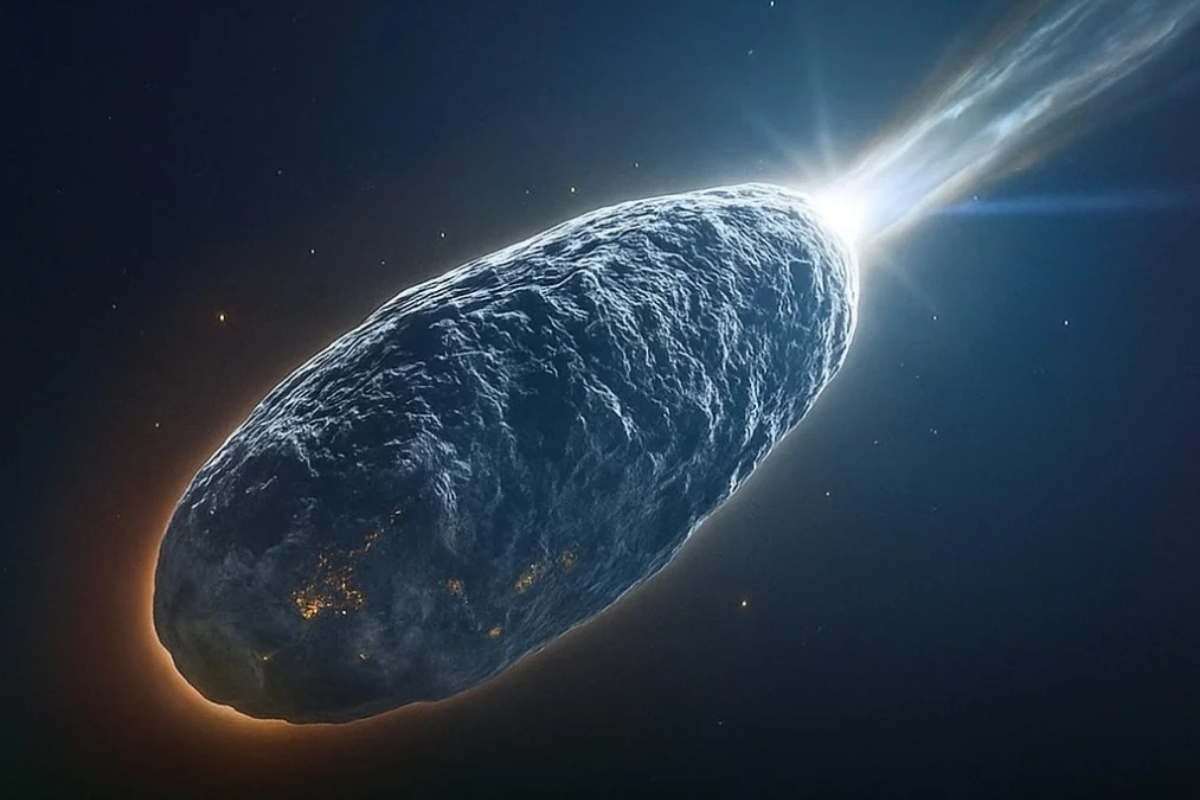Science
Harvard Astrophysicist Suggests 3I/ATLAS Could Be Artificial

Avi Loeb, an astrophysicist at Harvard University, has put forth a bold hypothesis regarding the interstellar object known as 3I/ATLAS. He suggests that if this celestial body, initially identified as a comet, does not exhibit a detectable gas cloud, it could challenge traditional views and imply the presence of artificial technology. The object has generated significant intrigue among astronomers since its discovery by the ATLAS survey team in Rio Hurtado, Chile, on July 1, 2025.
3I/ATLAS is notable as the third confirmed interstellar object to pass through our solar system. Unlike typical comets that orbit the Sun, this object originates from beyond the heliosphere, having likely been expelled from a distant star system billions of years ago. Its hyperbolic trajectory indicates that its velocity exceeds the escape speed of the Sun, with estimates suggesting it reaches up to 244,600 km/h. This rapid movement places it among a select group of interstellar objects, following the earlier visits of 1I/‘Oumuamua and 2I/Borisov.
Loeb’s assertion hinges on the absence of the expected cometary tail. He argues that without a visible gas cloud, the scientific community must consider the possibility that 3I/ATLAS is not a naturally occurring comet. Its central nucleus is estimated to measure between 0.44 and 5.6 km in diameter, which could mean a mass of at least 33 billion tons if it is solid. This makes it considerably larger than 2I/Borisov, its predecessor.
The perihelion, or closest approach to the Sun, occurred on October 29, 2025, at a distance of approximately 1.36 AU. This event intensified the Sun’s influence on the object, leading to unusual observations. Loeb highlighted that the surface area necessary to account for the mass flow in the jets observed extending towards the Sun seems implausible. He noted, “The surface area required to account for the mass flow in the large-scale jets… is untenable,” suggesting that the object would need to be larger than Manhattan Island to produce the observed effects.
Further complicating the analysis of 3I/ATLAS is its unexpected non-gravitational acceleration. Observations from the Atacama Large Millimeter/submillimeter Array (ALMA) revealed a 4 arcsecond deviation from its predicted path, indicating an additional force at play. This acceleration, measured at 0.02 mm/s² over 50 days, resulted in a velocity change of 86 m/s. This phenomenon could typically be attributed to the “rocket effect” seen in natural comets, where gas and dust are expelled unevenly. However, the lack of visible outgassing raises questions about the mechanisms behind 3I/ATLAS’s behaviour.
As researchers continue to analyze this enigmatic object, its changing colour has also captured attention. Prior to perihelion, 3I/ATLAS appeared reddish, but it shifted to a deep blue during its closest approach. This unusual colouration may be due to ionised carbon monoxide emissions, rather than the dusty appearance typically associated with comets. Notably, the comet brightened significantly just before perihelion, suggesting rapid material ejection.
Loeb has identified multiple anomalies related to 3I/ATLAS, including its orbit, which closely aligns with the solar system’s plane, an occurrence rarely seen in simulations. The timing of its closest approach during solar conjunction, when it was obscured by the Sun, further complicates observations. The object’s size and velocity also stand out; it is approximately one million times the mass of ‘Oumuamua and twice as fast.
The chemical composition of 3I/ATLAS, rich in carbon dioxide and nickel but lacking in iron or water, raises additional questions. The negative light polarization observed is also unprecedented for a comet. Loeb posits that if future observations, particularly those scheduled for December 2025, do not reveal a gas cloud consistent with necessary material loss, it may support the theory of artificial propulsion.
Critics of Loeb’s hypothesis argue that natural variability could explain the observed anomalies. Interstellar objects, having been subject to cosmic radiation over extensive periods, may develop hard surfaces that trap volatile materials, leading to unpredictable gas bursts. The high levels of carbon dioxide and metal vapours could suggest formation in a carbon-rich protoplanetary disk. Similar phenomena, including anti-tails and jet patterns, have been documented in other comets.
The implications of 3I/ATLAS extend beyond its immediate anomalies. Its unique characteristics may provide new insights into the formation of celestial bodies outside our solar system. Future observations from NASA’s ExoMars Trace Gas Orbiter and ESA’s Hubble telescope, along with ground-based observatories, will be crucial in testing predictions regarding mass loss and the object’s composition.
In summary, while 3I/ATLAS presents several perplexing behaviours that challenge conventional cometary models, ongoing research continues to explore its nature. The possibility of artificial origins remains a provocative idea, but more data will be necessary to draw definitive conclusions. As scientists strive to understand this extraordinary interstellar visitor, the case of 3I/ATLAS emphasizes the importance of interdisciplinary approaches in astronomy and the need for rigorous scientific inquiry to elucidate the mysteries of our universe.
-

 Health2 months ago
Health2 months agoNeurologist Warns Excessive Use of Supplements Can Harm Brain
-

 Health3 months ago
Health3 months agoFiona Phillips’ Husband Shares Heartfelt Update on Her Alzheimer’s Journey
-

 Science4 weeks ago
Science4 weeks agoBrian Cox Addresses Claims of Alien Probe in 3I/ATLAS Discovery
-

 Science3 weeks ago
Science3 weeks agoNASA Investigates Unusual Comet 3I/ATLAS; New Findings Emerge
-

 Science3 weeks ago
Science3 weeks agoScientists Examine 3I/ATLAS: Alien Artifact or Cosmic Oddity?
-

 Science3 weeks ago
Science3 weeks agoNASA Investigates Speedy Object 3I/ATLAS, Sparking Speculation
-

 Entertainment4 months ago
Entertainment4 months agoKerry Katona Discusses Future Baby Plans and Brian McFadden’s Wedding
-

 World2 months ago
World2 months agoCole Palmer’s Cryptic Message to Kobbie Mainoo Following Loan Talks
-

 Entertainment4 months ago
Entertainment4 months agoEmmerdale Faces Tension as Dylan and April’s Lives Hang in the Balance
-

 Science3 weeks ago
Science3 weeks agoNASA Scientists Explore Origins of 3I/ATLAS, a Fast-Moving Visitor
-

 Entertainment4 months ago
Entertainment4 months agoLove Island Star Toni Laite’s Mother Expresses Disappointment Over Coupling Decision
-

 Entertainment3 months ago
Entertainment3 months agoMajor Cast Changes at Coronation Street: Exits and Returns in 2025









